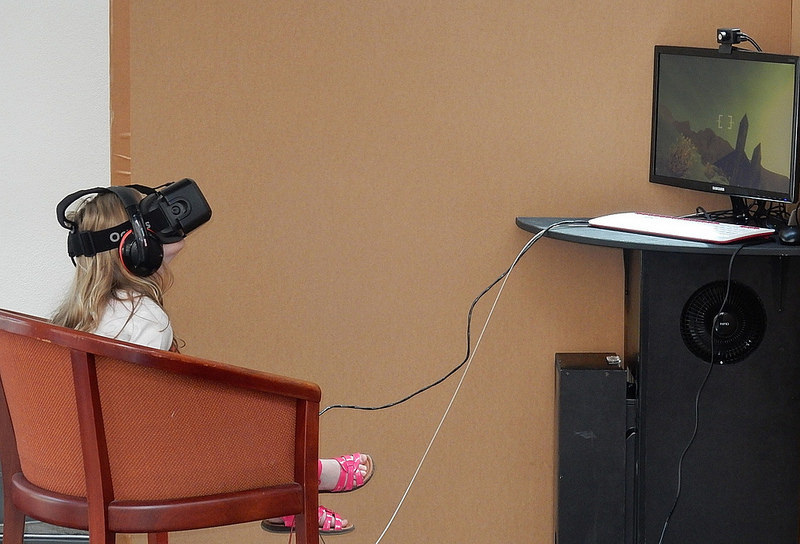EdTEch 541 Blog
“Games make us happy because they are hard work that we choose for ourselves, and it turns out that almost nothing makes us happier than good, hard work” (McGonigal, 2011). In her book, Reality is Broken, Jane McGonigal states “..in a good computer or video game you’re always playing on the very edge of your skill level, always on the brink of falling off. When you do fall off, you feel the urge to climb back on. That’s because there is virtually nothing as engaging as this state of working at the very limits of your ability—or what both game designers and psychologists call “flow.”4 When you are in a state of flow, you want to stay there: both quitting and winning are equally unsatisfying outcomes” (McGonigal, 2011). As a teacher, what would be better than finding a way to engage and motivate students to work “at the very limits of [their] ability” (McGonigal, 2011)? Teachers complain of student apathy and unwillingness to work. Perhaps this is because students are not fully engaged by the mode or material they are called upon to learn. Student are plugged into digital content outside of school and unplugged when in school. What if they could plug in digitally, as well as be motivated to learn “at the very edge of [their] skill level” (McGonigal, 2011). That would be something to behold! What if students were fully engaged in a middle school English class? What if learning about punctuation and grammar were fun? These are all possible with a properly structured educational game. Learning and playing a game can be enjoyable, rather than drudgery, even when learning about the parts of speech. This is where the concept of “flow” comes in. According to the abstract of the research article, Effective affective user interface design in games, authors Johnson and Wiles state, “It is proposed that games, which are designed to generate positive affect, are most successful when they facilitate flow (Csikszentmihalyi 1992). Flow is a state of concentration, deep enjoyment, and total absorption in an activity. The study of games, and a resulting understanding of flow in games can inform the design of non-leisure software for positive affect” (Johnson & Wiles, 2003). So games can provide students a sense of flow while learning, if properly designed while meeting the students’ interests, allowing students to immerse themselves in the learning process. Getting students to be entertained by games is not the object, however. In his online Edutopia article, Michael Farber warns “Games that blur the line between fun and education can all too frequently fall into the trap of becoming "edutainment," thinly disguised educational software or "chocolate-covered broccoli" (Farber, 2014). So, as teachers, we do not want to chocolate coat healthy learning (broccoli) to make it palatable to students. Rather, we should engage students in the process of evaluating different digital learning tools. Faber concludes his article with this recommendation: “An engaging way to alleviate chocolate-covered broccoli concerns is to bring the class into the mix by asking students to playtest. After all, Serious Games are not replacements for the teacher” (Farber, 2014). The teacher and students work together, to ensure that educational games warrant the time and effort to yield learning goals our students deserve. Farber, M. (2014, February 19). Why Serious Games Are Not Chocolate-Covered Broccoli. Retrieved March 06, 2016, from http://www.edutopia.org/blog/serious-games-not-chocolate-broccoli-matthew-farber Johnson, D., & Wiles, J. (2003). Effective affective user interface design in games. Ergonomics, 46(13-14), 1332-1345. McGonigal, Jane (2011-01-20). Reality Is Broken: Why Games Make Us Better and How They Can Change the World (Kindle Locations 437-440). Penguin Publishing Group. Kindle Edition. McGonigal, Jane (2011-01-20). Reality Is Broken: Why Games Make Us Better and How They Can Change the World (Kindle Locations 489-490). Penguin Publishing Group. Kindle Edition.
4 Comments
Janice Kane
3/13/2016 05:13:00 am
I agree, we do complain about apathy and unwillingness to work. Kids are so distracted and show very little interest in school. If everything could be presented in game format I'm sure a lot of the students would be more engaged. It's such a journey though. How would we do it? I think about our school, where the classroom teachers are stretched to their limits. They barely have time to meet the needs the current tasks that the district has given them. When I attempt to integrate Tech time with them, it's a struggle to find the time. I think it would be really helpful, when looking at new materials, if there schools would consider digital programs instead of books. Publishing companies need to go more digital so that programs include more digital aspects, are aligned to standards, and are cost effective.
Reply
3/13/2016 05:51:05 am
Thanks, Janice for your thoughtful comments.
Reply
Micheal Powell
3/14/2016 08:07:32 pm
You mentioned that students are plugged in at home but are not at school. I really think that this is crazy to do this to our students. That is like making students a few years ago leave their pens and pencils at home and use coal or rocks and chisels to write with. Students should be able to use the same technology at school that they use at home. You did a great job on this discussion.
Reply
Hi Janice
Reply
Your comment will be posted after it is approved.
Leave a Reply. |
Judy BlakeneyI am a Middles School Instructional Coach working on a Ed.D. in Educational Technology at Boise State University, in the 2016 Cohort. Archives
April 2016
Categories |

 RSS Feed
RSS Feed